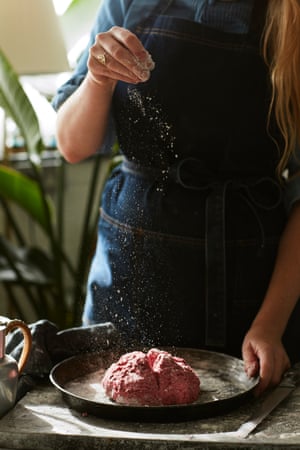Iwouldn’t call myself a baker, but I have found myself baking bread in some unusual situations; cowboy bread in big cast-iron pots around campfires, and flatbreads on a fire pit on a Navajo reservation in Arizona. I spent a few days working in a supermarket bakery, baking loaves from frozen in vast, eerie ovens. But the jewel in the crown, and where I learned the most about bread, was a few months spent baking with my dear friend Tom Herbert, from Hobbs House bakery just outside Bristol. Tom comes from a long family line of amazing bakers. He taught me a lot about bread.
So many people avoid bread these days – some for serious health reasons. For others, a lot of it is probably down to bad bread. The standard loaves our generation has grown up with have a lot to answer for – I’ve seen first hand what goes into them, and it’s no wonder a lot of people react badly. Most of them have a long list of additives, as you can see for yourself by looking on the labels. The industrial process strips the flour of most of its goodness and can be processed so fast it feels as if the last bit of fermenting is done in our stomachs.
My time in the supermarket bakery changed how I look at bread, and I buy the best stuff I can get my hands on. My local bakery is a couple of miles away, but I make the effort to pass by there once a week. They make sourdough breads that we eat with at least one meal a day. This is small-batch stuff, mostly using a sourdough starter, allowing long, slow proves to let the yeast do all its work: a completely different experience. Sure, it is a little dearer – but a proper crust means it lasts longer, so less is wasted.
As the nights draw in, I am drawn to baking bread – it’s the sort of cooking that allows me to switch off for the day and, more often than not, it happens at the weekend with a little boy kicking at my heels. I follow my wise mother-in-law’s advice when I do it – baking two loaves, keeping one fresh and slicing one for the freezer.
I like a bread with a mix of a white flour – usually white spelt for a good rise, a nice crumb and a lightness that toasts well – and another more interesting and textured wholemeal or rye flour for some depth.
The recipes that follow are my current favourite loaves: one half spelt and half rye, with a little honey and lots of seeds – it’s a rye bread that isn’t too serious, but has that malty, savoury back note that rye brings.
The other is an easy soda bread, lurid pink from the beetroot and mixed with fennel and caraway to counter the sweetness of the beets, and to help with digestion. Slicing a still-warm-from-the-oven bread satisfies and nourishes me in a way a thousand green juices couldn’t – and how happy I am about that.
Beetroot and caraway soda bread
Using soda is such a happy way to make bread: no waiting for rising and very little that can go wrong. You can use yoghurt let down with a couple of spoonfuls of milk instead of buttermilk if you like. It’s worth roasting the beetroot yourself rather than buying pre-cooked, as it provides a much more intense flavour.
Makes 1 x 750g loaf
300g cooked beetroot, chopped
1 tsp fennel seeds
1 tsp caraway seeds
100ml buttermilk or plain yoghurt
200g white spelt flour
200g wholemeal spelt flour
50g pumpkin seeds, plus more for sprinkling
1 tsp sea salt
2 tsp bicarbonate of soda
Black pepper
1 Preheat the oven to 220C/425F/gas mark 7. Put the beetroot (see the note if you’re roasting your own), spices and buttermilk in a food processor and puree until smooth.
2 Put the flours, pumpkin seeds, salt, bicarbonate of soda and pepper into a large bowl and mix well.
3 Pour the beetroot mixture into the flours and mix with a fork until well combined, then use your hands to bring the lot into a rough ball. Don’t knead it though, or it will make the finished loaf tough.
4 Scatter some flour over a baking sheet and put your ball of dough on top. Dust with a little more flour and a few more pumpkin seeds.
5 Cut a deep cross in the bread, then bake for 40 minutes, or until golden and risen. Remove from the oven and tap the bottom of the loaf. If you get a hollow sound, it’s perfect, so pop it on a wire rack to cool. This is delicious warm with salted or almond butter.
If you are roasting the beetroot yourself:
Wash the beetroot well and trim off the stalks. Place the whole beetroot in a foil parcel, wrapped really tightly so the steam doesn’t escape. Cook for around an hour (depending on the size of your beetroot) until a tender. Once cooked, allow to cool in the foil parcel, this will make it really easy to remove the skins. When cool enough to handle slip the skins off and discard. Extra roasted beetroot can be used in salads or alongside dips such as hummus.
Seeded rye bread (main picture)
The darker the rye flour you use the more deep and savoury your bread will be. I used a dark rye flour bought from the supermarket: the rise will be a little slower than a normal bread as rye flour is heavier, so don’t expect the usual doubling in size; it will rise by about half. A teaspoon of spices – cumin, caraway and fennel – all make a lovely addition here, too.
Makes 1 x 800g loaf
2 tsp (10g) dried yeast
350g warm water
3 tbsp runny honey
250g dark rye flour
250g white spelt flour
1 tsp fine sea salt
50g seeds, plus extra to sprinkle (I use poppy and sunflower)
Olive oil, for greasing
1 Dissolve the yeast in the warm water, add the honey and set aside.
2 Combine both flours in a large mixing bowl along with the salt and seeds, then mix well.
3 Pour the yeast and water over the flours. Mix first with a fork, then with your hands, until you have a sticky dough. Tip it out on to a floured chopping board or work surface. Form the dough into a ball, then knead by hand, pulling and stretching the dough for 4-5 minutes. If you have a stand mixer with a dough hook you can use it to get the dough to this point.
4 Lightly oil the bowl, then return the dough to it, cover with a tea towel or clingfilm and set aside in a warm place for about an hour, or until the dough has risen by half (remember it won’t rise as much as a normal loaf because of the rye flour).
5 Remove the dough from the bowl, put on a lightly floured board and knead again briefly – for just a minute or two.
6 Shape the dough into a flat oval and put it on an floured baking tray. Cover with the tea towel again and leave to rise once more for 30 minutes or so, until it has risen by half again. Preheat the oven to 240C/475F/gas mark 9.
7 After 30 minutes, use a sharp knife to slash the top of the dough in a criss‑cross pattern, then scatter the seeds over the top.
8 Half-fill a deep baking tray with boiling water and put it on the bottom of your oven. This will create steam as the loaf bakes and help give your bread a lovely crust and texture.
9 Bake the loaf for 30–35 minutes, or until golden all over. Be really careful when you open the oven door, as some hot steam may come out. To check if your bread is ready, lift it up and give it a tap on the bottom. If it sounds hollow, like a drum, it’s good to go. Cool on a wire rack so the bottom keeps its lovely crust.
Baker Tom Herbert’s tips for baking at home
Don’t be a flour floozy Flours might look the same but they aren’t. Find a good one and stick with it so you always know what you are working with.
The wetter the better If your dough feels too firm, add more liquid. A dry dough means you will bake a dry loaf.
Knead your dough for long enoughThis is the most wonderful stress-busting work out I know and it’ll help make your dough more stretchy so it rises well.
Bake your bread hot and fast Ideally on a baking stone.
Share your bread Life is better when you share something you’ve made – and what could be more timeless and nourishing than eating a loaf with your companions?
• Anna Jones is a chef, writer and author of A Modern Way to Eat and A Modern Way to Cook (Fourth Estate); annajones.co.uk; @we_are_food











